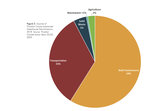

“It is no longer enough just to change our lifestyles. We need to be changing our communities,” reads a quote from Kaylee Shen, an Olympia High School student.
The quote kicks off the introductory chapter to the Thurston Climate Mitigation Plan (TCMP). It’s a lengthy document that’s been in the works for years, with a goal to cut Thurston County’s greenhouse gas emissions by 85 percent by 2050.
On Thursday, a steering committee approved the TCMP’s final version. Meaning, soon it will go before the Olympia, Lacey and Tumwater city councils and the Thurston County Board of Commissioners for separate adopting votes.
TCMP was created with cooperation from the Thurston Regional Planning Council, officials across multiple city jurisdictions and an array of experts and volunteers. They’ve held numerous events to gather public input on how community members think climate change can be combatted from a local perspective.
But before all of that came the data. The Thurston Climate Action Team (TCAT) has been compiling a greenhouse gas inventory since 2013, said TCAT Board President Tom Crawford.
Crawford, in an interview with The JOLT, described the process of gathering data on greenhouse gas emissions on a local level, which came largely from gathering and analyzing data from multiple organizations and departments.
The International Council for Local Environmental Initiatives (ICLEI) lays out protocol for small communities to do their own inventory on greenhouse gas emissions. For Thurston County, that meant gathering energy use data from Puget Sound Energy, transportation data from the Thurston Regional Planning Council, water and wastewater data from the LOTT Alliance for Clean Energy and other local and federal sources.
Sorting through all of that data has largely been volunteer work, said Crawford. The TCAT tracked emissions between 2010 and 2018. In its most recent report, published this summer — tracking the years 2015 to 2018 — the TCAT shows emissions increasing 10 percent between 2015 and 2017, and then dropping three percent in 2018.
The data show local energy consumption in buildings represented 55 percent of all emissions in 2018. Transportation followed at 33 percent, waste at 5 percent and agriculture at 3 percent (see chart, above).
This data is fueling the TCMP, the most comprehensive climate plan developed in Thurston County. Crawford said TCAT, somewhere around 2013, began presenting their findings to different city council meetings and to the Thurston County Board of Commissioners.
The organization was no stranger to working with public officials on climate-related projects. After forming in 2008, the TCAT’s first major effort was drafting a proposal with the Economic Development Council, resulting in Thurston County receiving $1.5 million in American Reinvestment Recovery Act funds to promote energy efficiency in homes and small businesses. Hundreds of homeowners improved their energy efficiency over the next three years, Crawford said.
“I think I can legitimately say that we have played a role in encouraging and motivating and providing informational resources that have helped the cities and the county make this plan,” said Crawford.
While each of the cities had formed separate plans to be energy-efficient, Olympia joined a nationwide coalition of cities that pledged to create climate plans. That led to further conversations among other local jurisdictions, and the ultimate decision that the three cities and the county would work together on a masterplan.
“Climate change is a global threat that has no borders,” reads a passage within the TCMP. “It will take meaningful action from governments and individuals across the country and around the world to change course. The Thurston region makes up just a small portion of that large puzzle. But by starting locally, we can do our part and show others the way.”
During a recent Olympia City Council meeting, Director of Public Works Rich Hoey — who serves on the plan steering committee — said they had originally received 300 possible methods to reducing emissions, largely through public input. That number was whittled down to the 70 most feasible and effective.
As previously reported in The JOLT, recently passed state laws aimed at making the state’s energy grids green will go a long way in helping the plan reach it’s goal. The statewide Clean Energy Transformation Act has already set the ambitious goal of making the state run on 100 percent reusable energy by 2045.
The draft plan also prioritizes changes in transportation, including improvements to public transit, increasing walkability and biking and encouraging electric vehicles.
The TCMP can be read in its entirety at: https://www.trpc.org/DocumentCenter/View/8084/TCMP_00_NovemberDraft_Chapters
Comments
No comments on this item Please log in to comment by clicking here